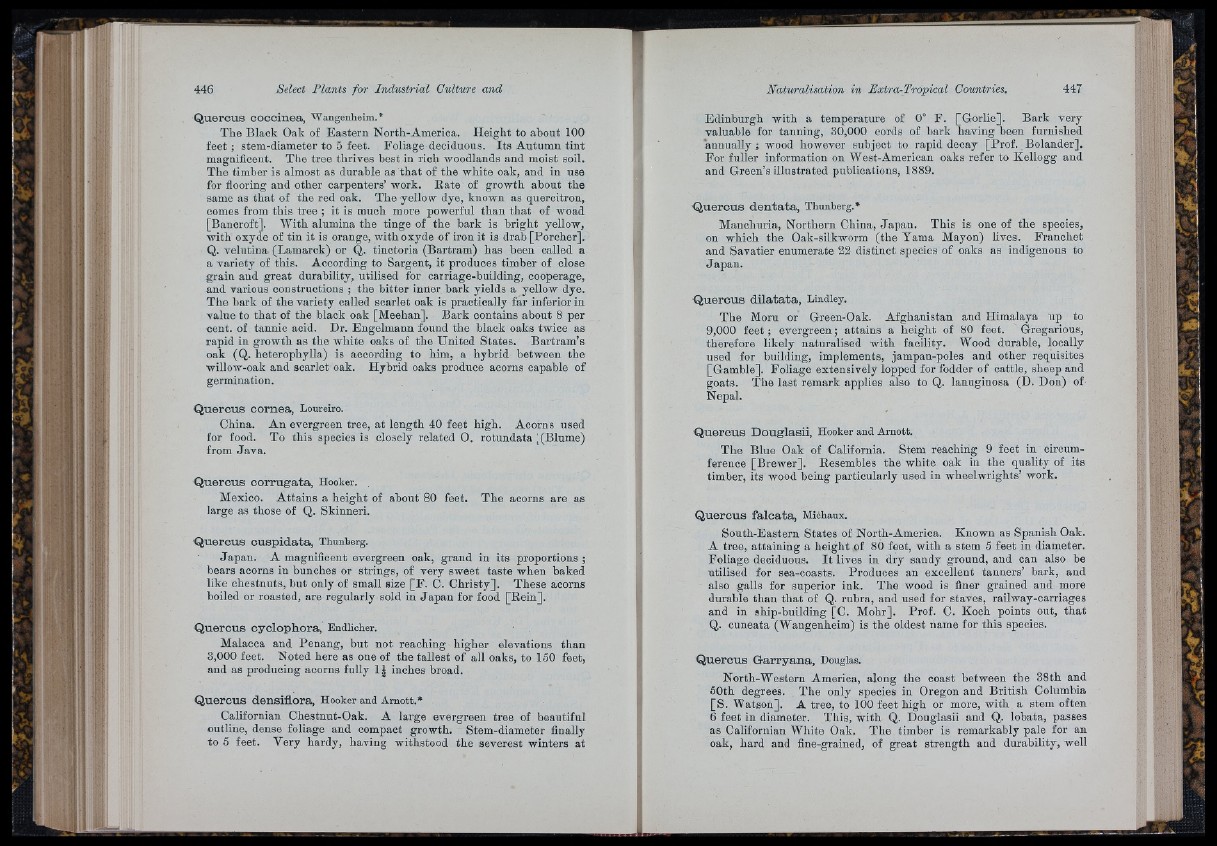
lis ■; I
I;
I' i -
Í
;
• i,
446 Select Plants for Industrial Culture and
Q u e r c u s co c c ín e a , Wangenheim.*
The Black Oak of Eastern North-Ameriea. Height to about 100
feet ; stem-diameter to 5 feet. Foliage deciduous. Its Autumn tint
magnificent. The tree thrives best in rich woodlands and moist soil.
The timber is almost as durable as th a t of the wliite oak, and in use
for flooring and other carpenters’ work. Rate of growth about the
same as th a t of the red oak. The yellow dye, known as quercitron,
comes from this tree ; it is ranch more powerful than that of woad
[Bancroft], With alumina the tinge of the bark is bright yellow,
with oxyde of tin it is orange, with oxyde of iron it is drab [Porcher].
Q. velutina (Lamarck) or Q. tinctoria (Bartram) has been called a
a variety of this. According to Sargent, it produces timber of close
grain aud great durability, utilised for carriage-building, cooperage,
and various constructions ; the bitter inner hark yields a yellow dye.
The bark of the variety called scarlet oak is practically far inferior in
value to th a t of the black oak [Meehan]. Bark contains about 8 per
cent, of tannic acid. Dr. Engelmann found the black oaks twice as
rapid in growth as the white oaks of the United States. Bartram’s
oak (Q. heterophylla) is according to him, a hybrid between the
willow-oak and scarlet oak. Hybrid oaks produce acorns capable of
germination.
Q u e r c u s c o ru e a , Loureiro.
China. An evergreen tree, a t length 40 feet high. Acorns used
for food. To this species is closely related O. rotundata ,(Blume)
from Jav a.
Q u e rc u s c o r ru g a ta , Hooker.
Mexico. Attains a height of about 80 feet. The acorns are as
large as those of Q. Skinneri.
Q u e r c u s c u s p id a ta , Thunberg.
Japan. A magnificent evergreen oak, grand in its proportions ;
bears acorns in bunches or strings, of very sweet taste when baked
like chestnuts, but only of small size [F . C. Christy]. These acorns
boiled or roasted, are regularly sold in Jap an for food [Rein].
Q u e r c u s c y c lo p h o ra , Endlicher.
Malacca and Penang, but not reaching higher elevations than
3,000 feet. Noted here as one of the tallest of all oaks, to 150 feet,
and as producing acorns fully I J inches broad.
Q u e rc u s d eu siflo ra , Hooker and Arnott.*
Californian Chestnut-Oak. A large evergreen tree of beautiful
outline, dense foliage and compact growth. Stem-diameter finally
to 5 feet. Very hardy, having withstood the severest winters at
Naturalisation in Extra-Tropical Countries. 447
Edinburgh with a temperature of 0° F. [Gorlie]. Bark very
valuable for tanning, 30,000 cords of bark having been furnished
annually ; wood however subject to rapid decay [Prof. Bolander].
For fuller information on West-American oaks refer to Kellogg aud
and Green’s illustrated publications, 1889.
Q u e r c u s d e u ta ta , Thunberg.»
Manchuria, Northern China, Jap an . This is one of the species,
on which the Oak-silkworm (the Yama Mayon) lives. Franchet
and Savatier enumerate 22 distinct species of oaks as indigenous to
Japan.
Q u e r c u s d ila ta ta , Lindley.
The Morn or Green-Oak. Afghanistan and Himalaya np to
9,000 feet ; evergreen; attains a height of 80 feet. Gregarious,
therefore likely naturalised with facility. Wood durable, locally
used for building, implements, jampan-poles and other requisites
[Gamble]. Foliage extensively lopped for fodder of cattle, sheep and
goats. The last remark applies also to Q. lanuginosa (D. Don) of
Nepal.
Q u e r c u s D o u g la sii, Hooker and Arnott.
The Blue Oak of California. Stem reaching 9 feet in circumference
[Brewer]. Resembles the white oak in the quality of its
timber, its wood being particularly used iu wheelwrights’ work.
Q u e r c u s f a lc a ta , Miohaux.
South-Eastern States of North-America. Known as Spanish Oak.
A tree, attaining a height of 80 feet, with a stem 5 feet iu diameter.
Foliage deciduous. I t lives in dry sandy ground, and can also be
utilised for sea-coasts. Produces an excellent tanners’ bark, aud
also galls for superior ink. The wood is finer grained and more
durable than th a t of Q. rubra, and used for staves, railway-carriages
and in ship-building [C. Mohr]. Prof. C. Koch points out, that
Q. cuneata (Wangenheim) is the oldest name for this species.
Q u e rc u s G a r ry a n a , Douglas.
North-Western America, along the coast between the 38th and
50th degrees. The only species in Oregon and British Columbia
[S . Watson]. A tree, to 100 feet high or more, with a stem often
6 feet in diameter. This, with Q. Douglasii and Q. lobata, passes
as Californian White Oak. The timber is remarkably pale for an
oak, hard and fine-grained, of great strength and durability, well